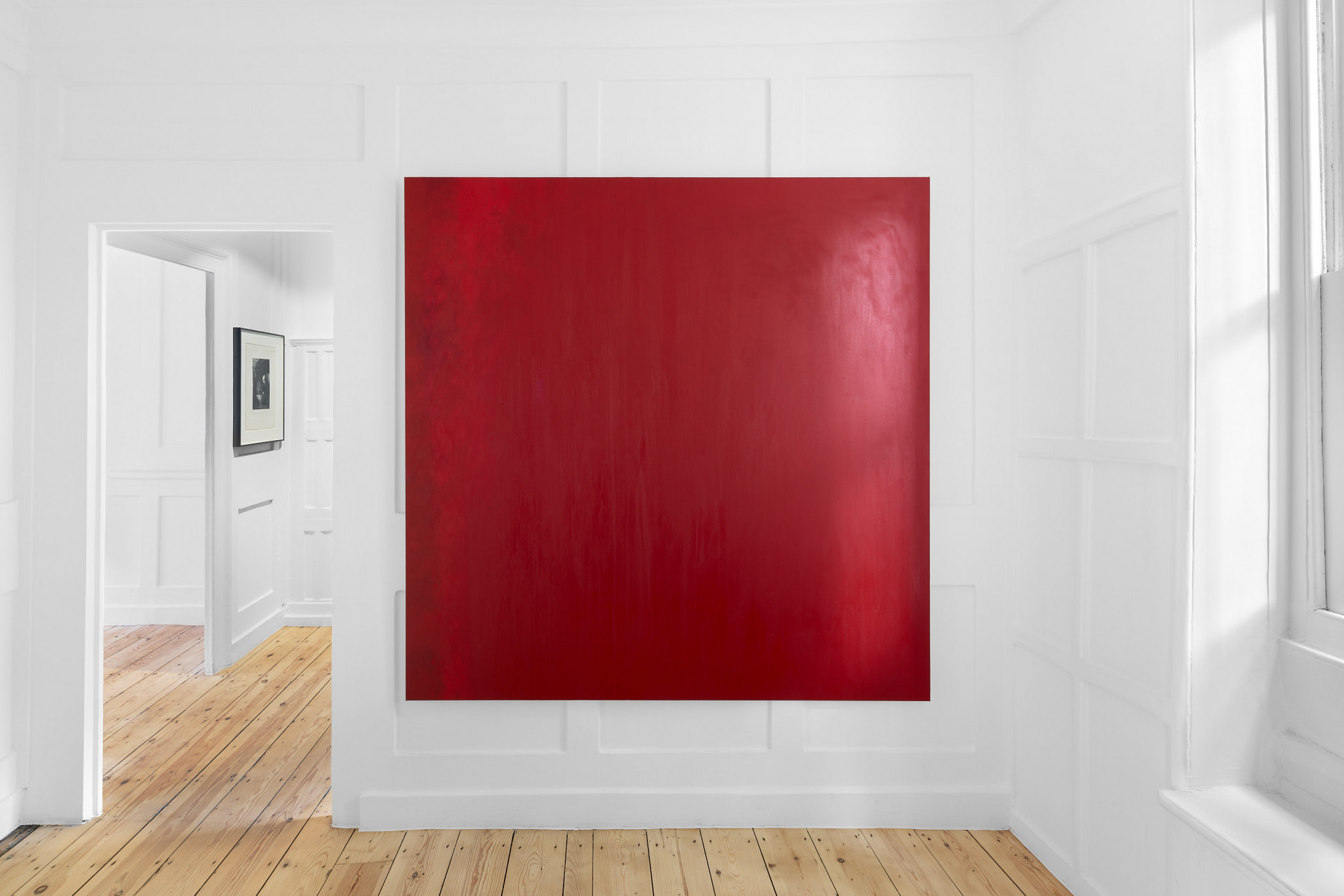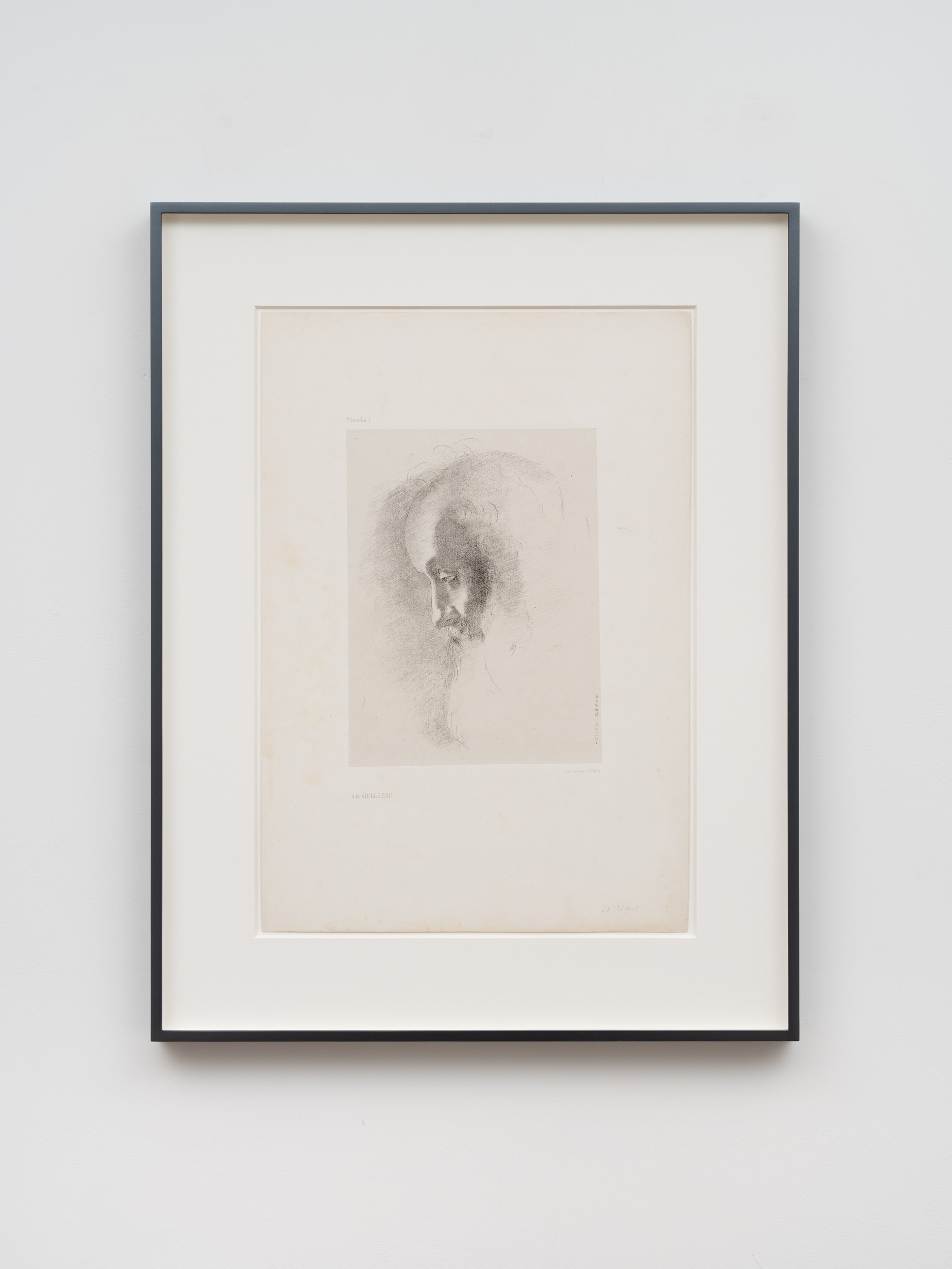And then there was light: two years after her last show at Emalin, Kate Spencer Stewart is back in London with a series of new canvases in glorious colour. This time, it is a double bill: Spencer Stewart’s paintings have been paired with a selection of Odilon Redon’s “noirs,” inky black lithographs from his La Nuit series (1886). This is the first exhibition at Emalin to include historical work.
When I think of Redon, I think of his later paintings, from the first decade of the 1900s—the ones that are so explosive with colour the figuration melts away before your eyes. Some of his great big pieces generate the anachronistic thrill of seeing an exhibition’s worth of colourfield work in one go, lashed together on a single canvas (but barely) by some kind of Symbolist imagery.

A mass of critical writing and scholarship on Redon analyses his anticipation of the drive to total abstraction a few decades later, but in this show Spencer Stewart tells us all we need to know in six paintings or less. Could you shatter a Redon painting into its constituent parts, extracting the figuration so that the colour is left to flourish on its own? This is what Spencer Stewart has achieved: six servings of deconstructed Redon. Six suspended expanses of shifting colour, six monochromatic lithographs sulking nearby to remind the viewer of what’s missing.
Consider La Nuit (1910-1911), not the body of work this exhibition is named after, but a panel Redon painted for the library of an old abbey that a friend of his repurposed into a country home. If you leaned too close to La Nuit and fell inside, Lewis Caroll-style, you’d find yourself in a Spencer Stewart exhibition. Lost in the blue-black of the upper right corner? You’re somewhere near Synth (2025), the first painting you see on the ground floor of the Clerk’s House. Stuck in the ethereal gold-and-white background that shifts through the centre of the work? You’re floating in Chime (2025), hanging up in the attic. Borrowing Redon’s own language, Spencer Stewart isolates the “single resources of light and darkness” and the “effects of the abstract line” that Redon felt were the origin of his work’s power.

What Redon has to offer in turn is a distraction from the abstractions, at just the right moments. “It can be insanely pleasurable or deeply frustrating to hear what one sees in a painting,” Spencer Stewart told the art historian Alex Bacon in a 2023 interview for Emalin Stories series. “My heart is with those who try; it is very difficult to describe a non-objective, basically colour-field painting. And why should they try? It’s my job to make sure there are no dragons hiding behind the clouds but people will always want to make sense of what they see.” The presence of the noirs takes some of this pressure off. They usher the dragons away from the paint—it makes it easier to see Spencer Stewart’s chiaroscuro as chiaroscuro for chiaroscuro’s sake if you have a set of floating heads and morose angels and variously veiled or cloaked humans nearby, reminding us what it is like to deploy the same technique in service of figuration.
However, nothing about the show is prescriptive: if you are looking to find direct connections between the paintings and the lithographs, you can have a field day establishing different programmatic ways to read the works together (the exhibition text gives you a head start with the suggestion to compare and contrast the chiaroscuro). If you are here to focus out the lithographs, you can don a pair of white archive gloves and leaf through the full folio in the back room on the ground floor. And if you are looking for the kind of transcendence that only one-on-one time with a large oil painting can offer, the Redon works are positioned so that they are only ever encountered before, or after, their accompanying Spencer Stewart painting—you are never going to catch both on one wall, or within a single field of view. The paintings can breathe.

Everything comes to a head in the attic, where we encounter Chime (2025). It is a wispy, feathery thing. It actually levitates in the space thanks to the lovely way that it has been mounted—the top rail of the stretcher rests on the narrow edges of two screw heads, and without any wall behind it to support it (the wall is the attic ceiling, which slopes away) it sways slightly in the breeze of new viewers entering the space and from the vibration of each bus passing by on Shoreditch High Street. The Clerk’s House attic is still unfinished, so Chime is free to play off various marks of age in the space in a way that the other paintings cannot on the crisp lower floors. A patch of water damage on the attic ceiling has cracked the plaster into a yellow and purple mess, which either brings out a purple underpainting in Chime or makes it impossible not to imagine one. For part of the day, when there’s direct sun, the composition is interrupted by the projection of four panes of light slanting across the lower lefthand side of the canvas, which smother the yellows and whites into a shimmering gold.
From the small wooden bench opposite the painting, if you manage to tear your eyes away, you can just catch the final lithograph, A La Viellesse (To Old Age). It is by far the lightest of the La Nuit series—it barely feels like a noir at all. The image depicts a man’s face in profile, which dissolves into the negative-space implication of a white willowy beard. The strands of this beard, the cracks in this plaster, the hairline ends of these brushstrokes on Chime: the suggestive power of the single line is infinite.
—
Kate Spencer Stewart (b. 1984 Phoenix, US) lives and works in Los Angeles, US. She graduated with a BFA from Otis College of Art and Design, Los Angeles, in 2006 and completed her MFA in painting at University of California, Los Angeles, in 2017. Recent solo exhibitions have been held at Paul Soto, Los Angeles, US (2025); Emalin, London, UK (2023); Bureau, New York, US (2022); La Maison de Rendez-Vous, Brussels, BE (2022); and The Gallery @ Le Hangar Restaurant, Paris, FR (2019). Stewart’s work has been included in group exhibitions held at Hannah Hoffman, Los Angeles, US (2025); Francesca Minini, Milan, IT (2025); Paul Soto, New York, US (2024); Hissss, Los Angeles, US (2024); ABERTO, São Paolo, BR (2023); Hakuna Matata, Los Angeles, US (2023); Emalin, London, UK (2022); Neuer Kunstverein Wien, Vienna, AT (2021); Andrew Kreps Gallery, New York, US (2021); and Piktogram Gallery Warsaw, PL (2019).
Odilon Redon (b. 1840, Bordeaux, FR; d. 1916, Paris, FR) was a French artist associated with Symbolism. He studied drawing in Bordeaux and later printmaking under Rodolphe Bresdin, as well as briefly pursuing architectural studies in Paris. Redon’s early career was marked by his charcoal drawings and lithographs—referred to as his noirs—which he began exhibiting in the 1870s. These works, notable for their psychological depth and imaginative imagery, align with the literary Symbolist movement and reflect Redon’s interest in spirituality, dreams and introspection. Following the 1890s, his practice shifted toward colour, producing luminous works in pastel and oil. Redon’s work was included in significant exhibitions of the time, such as the Salon des Indépendants and was championed by writers including J.K. Huysmans and Stéphane Mallarmé. His influence extended into early Modernism and his work is now held in the collections of institutions such as the Musée d'Orsay, Paris, FR; the Museum of Modern Art, New York, US; Tate, London, UK; and the Art Institute of Chicago, US.




